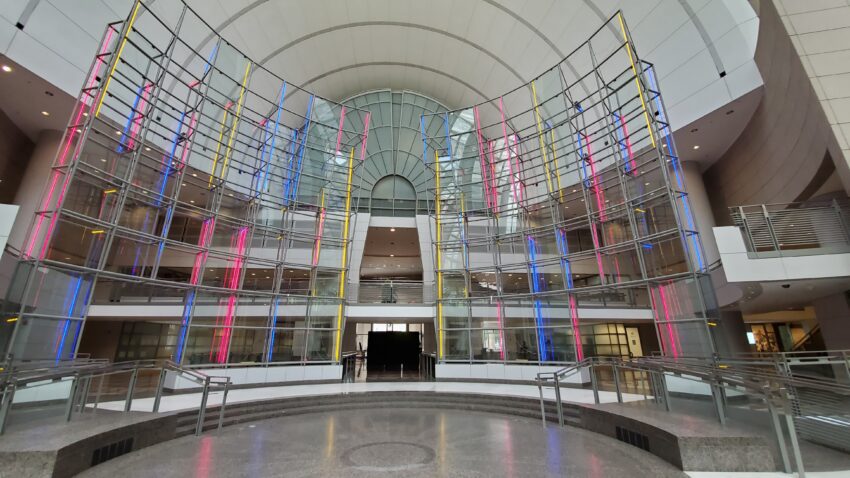Often the first step of an art conservation treatment is to perform a condition assessment. Jim Gwinner, Conservator of Public Art and Sculpture, recently performed an examination of neon artworks by artist Keith Sonnier in the D.C metropolitan area.

The two neon artworks are Cenozoic Codex, 1997 installed at the Census Data Processing Center in Bowie, Maryland and Route Zenith, 1997 installed at the Ronald Reagan Building and International Trade Center in D.C. These neon artworks are public art commissions through the General Services Administration Art-in-Architecture program. Each neon artwork is a multi-colored, large-scale installation, and they are in need of general maintenance cleaning, equipment updates, and new neon tubing.

Cenozoic Codex is a permanent installation of colored neon tubing installed on the Census Data Processing Center facade and lobby. Three colors: yellow, red, and blue were used by the artist. Seventy-six yellow tubes are horizontally mounted outdoors along the building’s awning, sixteen red tubes are horizontally mounted indoors in the lobby, and forty-three blue tubes are horizontally and vertically mounted throughout the main interior hallway.

Route Zenith is a permanent installation of two curvilinear “screen walls” comprised of steel and glass. It is located in the lobby of the Ronald Reagan Federal Building and International Trade Center. Neon tubes in primary colors are interspersed within the glass and metal structure. The two-screen walls are symmetrically installed on a central vertical axis with an opening between the two structures. The neon tubing has a nearly identical sequence in both walls, except that the red and blue tubing is reversed in one of the walls.

Route Zenith is particularly striking because the artist chose a larger diameter tube so the colors would be intense not only at night, but during daytime hours too.
While there are settled dusts and debris on each installation , the primary issues is failing equipment like the neon tubing and transformers reaching the end of their normal service life. As conservator Gwinner explains, “the typical lifespan of neon tube is about 30,000-50,000 thousand hours. Luminescence of the tubing gradually ‘falls off’ or deteriorates over time due to phosphor decay. The tubing must be replaced once the deterioration begins”. The decay results in a dimly lit tube to complete failure. Transformers also last about five to seven years.

Gwinner continued with his assessment of the two neon artworks. While there have been some interventions throughout the years, much of the equipment is original. Conservator Gwinner engaged the artist’s fabricator for the two neon artworks, Chris Freeman of Chris Freeman Designs. Freeman provided helpful information regarding installation, design, technical information, and Sonnier’s intentions; this information is critical for creating a treatment plan.
Gwinner suggested a total replacement of failing or aged components to be completed by a neon specialist in tandem with an overall maintenance cleaning completed by a professional conservator. The task of maintenance is especially tricky for Route Zenith because it can only be accessed from the top. In addition, the larger diameter tubes are no longer made, so they must be replaced with attic stock or fabricated new.

The McKay Lodge Conservation team specializes in the treatment of electronic media and optical artifact conservation. Conservators have treated other neon artworks in the recent past, including The White Tornado, 1979 by Rockne Krebs at The Frank Carlson Federal Building in Topeka, Kansas and Red Neon Circle Fragments on a Blue Wall, 1978 by Stephen Antonakos at the Federal Building and US Courthouse in Dayton, Ohio.
The artist Keith Sonnier was born in Mamou, Louisiana in 1941. Sonnier was a well-traveled artist with numerous works in museums around the United States and the globe. He is part of a group of artist who began experimenting with industrial and ephemeral materials in the 1960s. Sonnier is best known for his neon, florescent and reflective sculptures, though he worked in a variety of mediums from latex to video to found objects. The artist passed away in July of 2020, but you can read more about his life and work on his official website.
